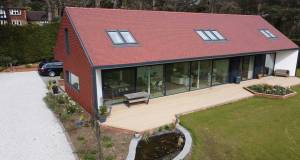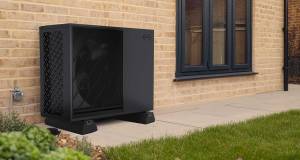
- Marketplace
- Posted
Ireland’s first 3D printed homes insulated with clay foam
Ireland’s first 3D printed housing project has been delivered in Dundalk – integrating Firetite aerated clay cavity wall insulation.
This article was originally published in issue 48 of Passive House Plus magazine. Want immediate access to all back issues and exclusive extra content? Click here to subscribe for as little as €15, or click here to receive the next issue free of charge
The collaboration between Louth County Council, Louth & Meath Education & Training Board, and Harcourt Technologies utilised 3D construction printing technology to construct a three-unit terrace of three-bed homes at Grange Close, Dundalk.
Harcourt Technologies (HTL) were awarded the opportunity to provide Louth County council with Irelands first 3D printed home at Grange Close. The project is the first social housing scheme in the world to combine 3D construction printing (3DCP) and ready-mix concrete – with a low embodied carbon mix.
A 3DCP construction method uses large-scale 3D printers onsite to create three-dimensional structures layer by layer. Layers of 50 mm ready-mix concrete are deposited through a gantry based 3DCP machine according to a digital model, eliminating the need for traditional blocks.
HTL MD Justin Kinsella said that the company had made particular efforts to reduce the embodied carbon of the system, by adjusting the concrete recipe – using the largest proportion of aggregate in the mix possible, meaning less cement binder, and larger sized aggregates. According to HTL director Jandré Oosthuizen: “The typical 3D printed building worldwide is currently constructed with a mortar material – concrete without large aggregates – which has a much higher cement content. The embodied carbon for the typical building would be roughly 450 kg CO2e/m3. I.e., we have roughly a 30 per cent saving,” and a cradle-to-factory gate total of 349 kg CO2e/m3.
At Grange Close, Firetite clay foam cavity wall insulation was chosen to fill the 3DCP cavity walls. The world’s first three component mineral clay insulation, Firetite has a thermal conductivity of 0.034W/mK. This self-sealing material also has the added benefit of providing a Class A2-s1:d0 fire rating eliminating the need for fire cavity barriers in the cavity wall.
With the best EMICODE emissions classification of EC1plus and contributing 30 points to any BREEAM building, Grange Close also benefits from Firetite’s environmental credentials.
For more information on Firetite visit econbp.com/firetite/, and for Harcourt Technologies visit www.htl.tech.
Related items
-
 New Ejot profile cuts thermal bridging losses by 25mm insulation equivalent
New Ejot profile cuts thermal bridging losses by 25mm insulation equivalent -
 Build Homes Better updates Isoquick certification to tackle brick support challenge
Build Homes Better updates Isoquick certification to tackle brick support challenge -
 Ecological Building Systems expands UK and Irish straw panel construction with EcoCocon deal
Ecological Building Systems expands UK and Irish straw panel construction with EcoCocon deal -
 Focus on better buildings, not better spreadsheets
Focus on better buildings, not better spreadsheets -
 MBC offers total passive house envelope solutions
MBC offers total passive house envelope solutions -
 Grant’s Aerona R290: A next-gen heat pump designed for the Irish climate
Grant’s Aerona R290: A next-gen heat pump designed for the Irish climate

